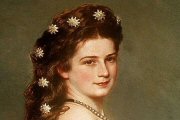Empress Elisabeth of Austria, who celebrated her 175th birthday on 24 December 2012, is remembered in many places.
The Sisi Chapel in Vienna am Cobenzl was built by Baron Johann Carl Freiherr von Sothen and his wife Franziska in 1854 on the occasion of the wedding of Empress Elisabeth to Emperor Franz Joseph. It serves as a burial place for the Sothens and was restored in 2005.

The most beautiful secessionist Sisi monument stands in the Volksgarten in Vienna.
On the back wall of the marble plinth stands:
"Her unforgettable Empress Elisabeth erected this monument in unchanging love and loyalty of Austria's peoples in 1907".
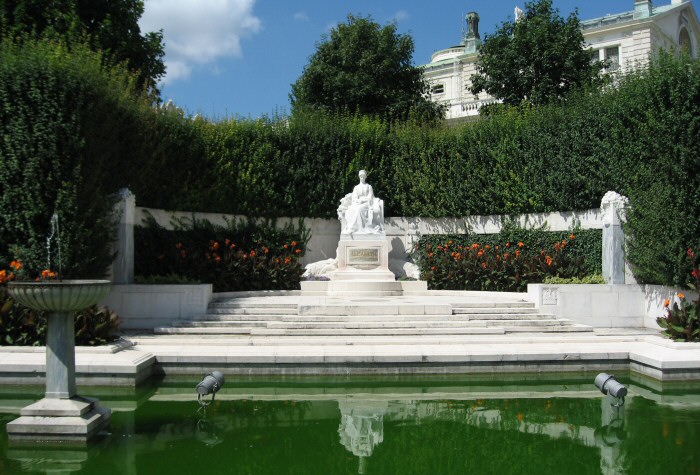
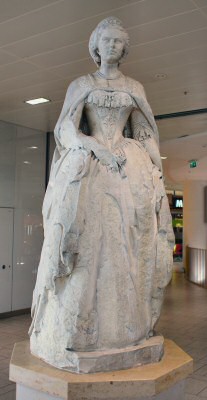
Her statue stands in Vienna's Westbahnhof (railway station west), formerly known as Kaiserin-Elisabeth Westbahnhof.
The translated inscription reads:
The portrait statue of Empress Elisabeth was once erected at the Westbahnhof in Vienna and illustrates the name "Empress Elisabeth Westbahn". The sculpture was created in 1860 by Hans Gasser. In 1945 the statue was severely damaged and restored for the Lower Austrian Provincial Exhibition in 1984.

The statue on the 1st floor of the renovated Westbahnhof.
(Photo Aug. 2012)
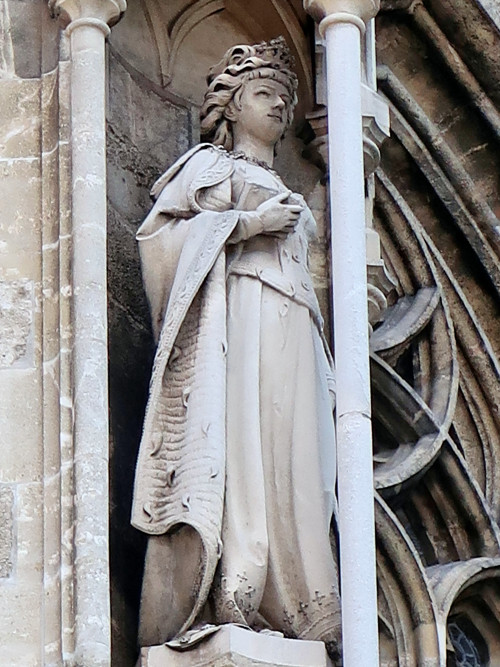
A statue of Empress Elisabeth stands at the north tower (eagle tower) of St. Stephen's Cathedral in Vienna.

At the Hermes Villa in the Lainzer Tiergarten there is a modern Sisi monument. It is called "Elisabeth Zwang - Flucht - Freiheit" and was carved from Carrara marble by Ulrike Truger (*1948). This sculpture is a counter image to the common Sisi cliché. The three sides of the sculpture stand for her personality, the fan for coercion, the mantle for escape and the wing for freedom.
More about the Hermes villa that Francis Joseph had built for his Sisi.
In Salzburg at Südtirolerplatz, at the main station stands Sisi's monument (after having stood in the palace park Hellbrunn for a long time.
Dein Österreich, du hast es hier betreten
Als Kaiserbraut in holder Majestät
und alle Herzen flogen dir entgegen
Ihr Jubelgruß war Segen war Gebet.
Dein Österreich, Du hast es hier betreten
Im Scheiden auch, geliebte Majestät
und wieder folgt Dir nach des Volkes Segen
und seine Tränen werden zum Gebet.
Your Austria, you have entered it here
As emperor's bride in holder majesty
and all hearts flew towards you
Her jubilation was blessing was prayer.
Your Austria, you have entered it here
In divorce also, beloved Majesty
and again follows you after the people's blessing
and his tears become prayer.

Here a photo from Hellbrunn from the year 2002
We just saw this Sisi statue in Salzburg. But Sisi was travelling a lot. Will their statues do the same? Here she is in Corfu in Achilleion.
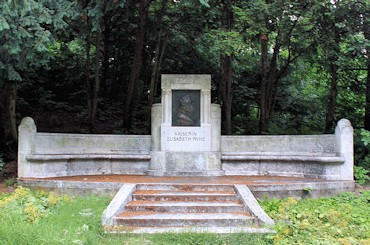
On the Kahlenberg, the local mountain of the Viennese, near the brick-built Stefanie Warte (observation tower, dedicated to the widow of Crown Prince Rudolf - Stefanie of Belgium) the monument Elisabeth-Ruhe (Elisabeth rest) with a bronze relief of the Empress was erected in 1904.
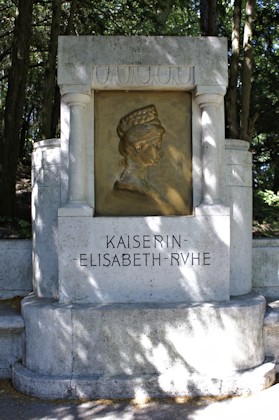
Allegedly Sisi liked to be here.


In Budapest at the Elisabeth Bridge (on the Buda side) this Elisabeth monument is located in a small park.
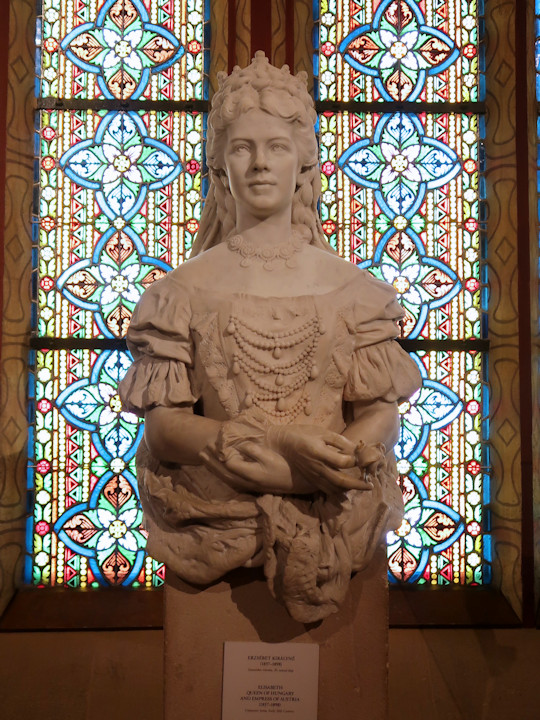
In the Matthias church (coronation church) in Budapest there is this statue of Elisabeth (in the museum on the gallery).

In Hungary in Szeget there is a huge marble monument.

Sisi, the Hungarian queen, loved Gödöllö very much.
After the queen's death (1898) the castle park was enlarged with an Elisabeth Park.
The wood, which can be reached directly from the old palace park and is richly planted with botanical rarities, was inaugurated in 1901 in the presence of Franz Joseph I. The park was also extended to include the palace gardens. The statue of Queen Elisabeth stands at the end of the avenue lined with four rows of lime trees.

Gödöllö Castle
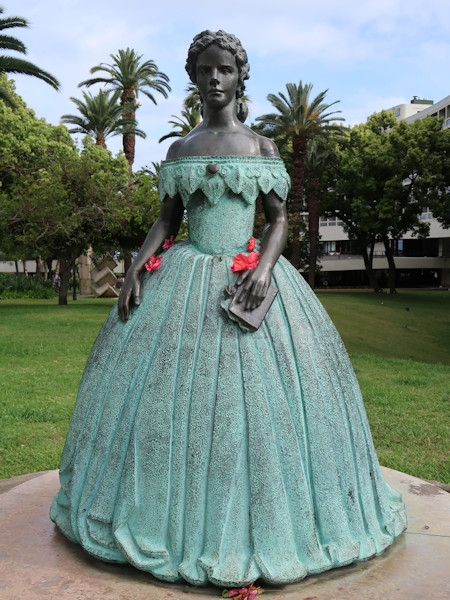
Sisi Monument in Funchal on the island of Madeira
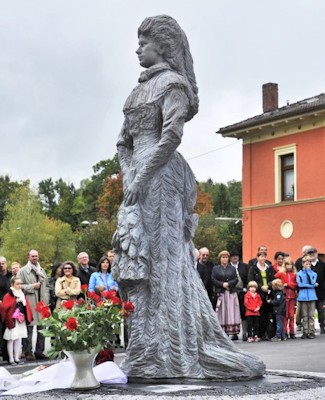
On 6 October 2013, a larger-than-life bronze statue of Elisabeth was ceremoniously unveiled on the forecourt of the Empress Elisabeth Museum in Possenhofen.
In 1870 and 1889 Elisabeth of Austria spent the winter in Merano in the mild climate of South Tyrol.

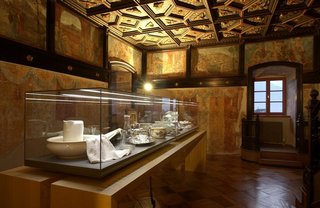
In October 1870 Empress Elisabeth of Austria arrived at Trauttmansdorff Castle in Meran to spend the winter months on the climatically preferred southern side of the Alps. Together with her two daughters Gisela (14) and Marie Valerie (2) she moved into the rooms on the top floor of the palace, which were furnished with frescoes and richly decorated wooden ceilings. The Empress's 102-person court occupied some of the manors and castles in the surrounding area.
Elisabeth stayed in the castle for seven months. During this time Emperor Franz Joseph visited the castle four times.
In September 1889 Empress Elisabeth moved into Trauttmansdorff Castle a second time. Eight months earlier, her son Crown Prince Rudolf had taken his own life in Mayerling. The now "black woman", Sisi, showed herself to be very withdrawn during her short stay and rarely left the castle.
Today a small museum is housed in the former living quarters of Sisi.


In front of Trauttmansdorff Castle on the Sisi Terrace stands the Sisi Throne. The inscription reads:
As a reminder
to the stay
His Majesty the Emperor and King
FRANCE JOSEF I.
and Her Majesty the
Empress and Queen
ELISABETH
in Trauttmansdorff Castle
in the years 1870 and 1889
Sisi Monument in the Botanical Garden near Villa Trauttmansdorff.
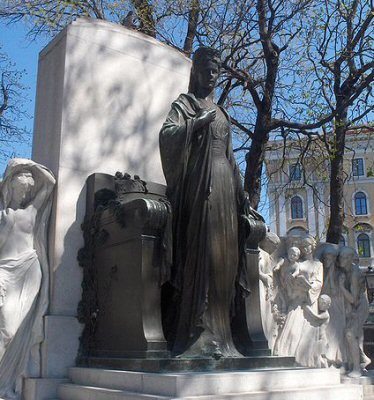
The monument in Trieste, unveiled in 1912 in honour of the Empress's visit, stood on the station square for only five years. Then the first anti-Austrian slogans were issued and the statue disappeared from its pedestal. The present city administration made the reassembly possible in 1997. The bronze monument, once created by the Viennese artist Franz Seifert, shows the Empress in front of a throne. A marble relief on which the figure stands shows a cheering crowd.

Sisi loved Venice. Since 2012, the Museo Correr at St. Mark's Square has been showing the Imperial Apartments, restored over 10 years ago, where Francis and Sisi spent happy days. Their picture is in the Audienzsaal
A view into the hall where Sisi received visitors in 1856/57 and 1861/62.

Click here for a picture of the Audience Hall with the Sisi Portrait


In Slovakia near Bardejov stands a monument to Sisi. She stayed there for a cure in the nearby spa Bardejovské Kúpele
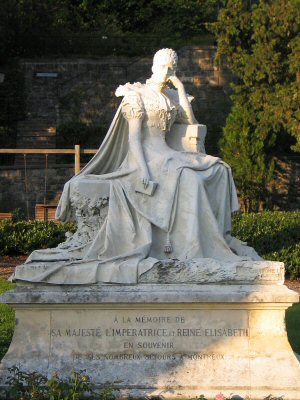
In Territet, a district of Montreux on the north-eastern side of Lake Geneva, there is a monument to Elisabeth which depicts her in the pose of a poet. Sisi sits on a
pedestal, in one hand she holds a book, on the other hand she supports her head thoughtfully. The statue was inaugurated four years after her death. It stands in the rose
garden opposite the railway station, next to the English Church. Together with the Rose Garden, the monument forms a total work of art. From Territet a steep road leads up to
Caux. Elisabeth last lived here. Today, nothing there reminds of Sisi. But the view of Lake Geneva is worth the trip to Caux.
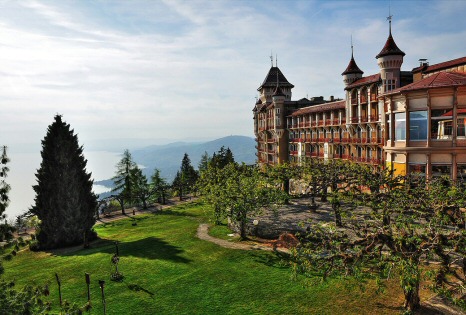
Territet was a popular holiday destination for Elisabeth. From here she made boat trips on the lake, made extensive hikes, visited sights in the area, such as Chillon Castle. In 1897 Elisabeth was visited in Territet by her nephew, Archduke Franz Ferdinand. Franz Joseph also often visited Lake Geneva to visit his wife.

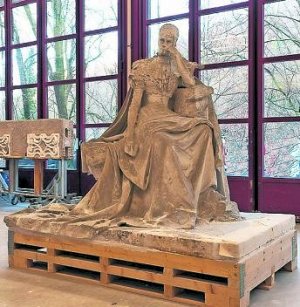
For many years, the plaster model for the monument stood alone in Territet and forgotten in a backyard on Corso Elvezia in Lugano.
When the house was sold, the plaster model was handed over to the city of Lugano. They handed it over to a research project
investigating the working techniques of the Chiattone family of artists. The further fate of the plaster model is unclear (as of June 2015).
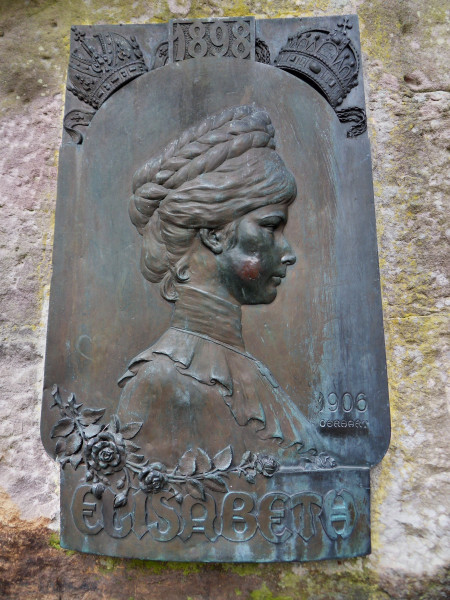
Sisi Monument at Altenberg near Bad Kissingen

Picture of the area
Sisi was very often and very gladly to the cure in Bad Kissingen. There she also met Ludwig II, the young king of Bavaria. The two of them are penned a royal romance. Elisabeth happily told her family about the "many hours she spent together" with Ludwig. He in turn wrote enthusiastic letters to Sisi.
But there must have been nothing but rapture, she wrote on 31 March 1865 to her then six and a half year old son Rudolf: "Yesterday the king made me a long visit, and if grandma hadn't finally come, he would still be there. He is completely reconciled, I was very kind, he kissed my hand so much that Aunt Sophie, who looked through the door, asked me afterwards if I still had her! "
And yet they kept coming back together. Because there was one thing that connected them without a doubt: a great "harmony", as Elisabeth called the astonishing similarity of the two.
Photos: Walter Martin alias Waldi

One last photo of Sisi and Franz Josef in the spa gardens of Bad Kissingen. She hid her face under an umbrella.
Photo digitally edited


colleriert detail and
detail b/w

Sisi stayed several times in Badgastein for a "Curaufenthalt" (stay at a health resort). This memorial stone reminds of it.
In Geneva, a modern Sisi memorial commemorates her tragic death.
There are many other Sisi monuments. I would like to thank you for all the reports on Sisi Memorials I have received.
As a curiosity I would like to mention the Sisi picture in the palace museum of Zanzibar (Spice Island near Madagascar) or what happened to Sisi's wedding dress!
